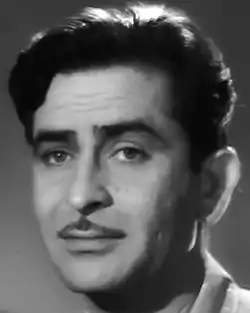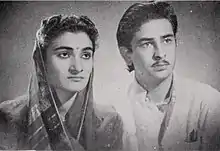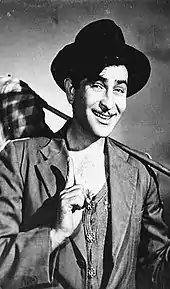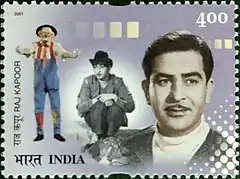Raj Kapoor
Raj Kapoor (born Shrishti Nath Kapoor;[1] 14 December 1924 – 2 June 1988) was an Indian film actor, producer and director of Indian cinema.[2] He is widely regarded as the greatest showman in the history of Indian cinema and entertainment.[3] He received multiple accolades, including three National Film Awards and 11 Filmfare Awards in India. The Filmfare Lifetime Achievement Award is named after Kapoor. He was a two-time nominee for the Palme d'Or grand prize at the Cannes Film Festival for his films Awaara (1951) and Boot Polish (1954). His performance in Awaara was ranked as one of the top ten greatest performances of all time by Time magazine.[4] His films attracted worldwide audiences, particularly in Asia and Europe.
Raj Kapoor | |
|---|---|
 Kapoor in the film Anari (1959) | |
| Born | Shrishti Nath Kapoor[1] 14 December 1924 |
| Died | 2 June 1988 (aged 63) |
| Other names | Ranbir Raj Kapoor The Showman, The Greatest Show Man of Indian Cinema, Charlie Chaplin of Indian Cinema, Raj Sahab |
| Occupation | Actor, producer, director |
| Years active | 1935–1988 |
Works | Full list |
| Spouse(s) | Krishna Kapoor
(m. 1946; |
| Children | Randhir Kapoor Ritu Nanda Rishi Kapoor Reema Jain Rajiv Kapoor |
| Parent(s) | Prithviraj Kapoor(father) Ramsarni Kapoor(mother) |
| Relatives | See Kapoor family |
| Awards | |
| Honours |
|
| Signature | |
 | |
The Government of India honoured him with the Padma Bhushan in 1971 for his contributions to the arts.[5] India's highest award in cinema, the Dadasaheb Phalke Award, was bestowed on him in 1987 by the Government of India.
Early life and background

Kapoor was born into a Khatri Punjabi Hindu family[6] in 1924 at Kapoor Haveli, a house then owned by his father in the Qissa Khwani Bazaar neighborhood of Peshawar, North-West Frontier Province in then British India, to Prithviraj Kapoor and Ramsarni Devi Kapoor.[7] He was the eldest sibling of six children in the family.[8][9] He was the grandson of Dewan Basheshwarnath Kapoor and great-grandson of Dewan Keshavmal Kapoor, part of the famous Kapoor family. His brothers were the late actors Shammi Kapoor and Shashi Kapoor. He also had a sister named Urmila Sial. Two other siblings died in infancy. They later on moved from Peshawar to present-day India for residence and for education. His father's cousin was film producer Surinder Kapoor, whose children are actors Anil and Sanjay and producer Boney Kapoor.[10] His maternal cousin, Juggal Kishore Mehra, was a singer, whose step-granddaughter, Salma Agha, later became an actress.
As Prithviraj moved from city to city early in his career during the 1930s, the family had to move too. Raj Kapoor attended several different schools like Colonel Brown Cambridge School, Dehradun and St Xavier's Collegiate School, Calcutta[11] and Mumbai.[12]
Career
At the age of ten, he appeared in Bollywood films for the first time, in 1935's Inquilab. Raj Kapoor's big break came with the lead role in Neel Kamal (1947) opposite Madhubala in her first role as a leading lady. In 1948, at the age of twenty-four, he established his own studio, R. K. Films, and became the youngest film director of his time making his directorial debut with Aag starring himself, Nargis, Kamini Kaushal and Premnath. In 1949 he co-starred alongside Dilip Kumar and Nargis in Mehboob Khan's hit film Andaz which was his first major success as an actor. He had his first success as producer, director and star of Barsaat released later that year.
He went on to produce and star in several hit films made under his R. K. Banner including Awaara (1951), Shree 420 (1955), Jagte Raho (1956) and Jis Desh Men Ganga Behti Hai (1960), the last was directed by Radhu Karmakar, his longtime cinematographer, and which won Filmfare Award for Best Film.[13] These films established his screen image modeled on Charlie Chaplin's most famous screen persona of The Tramp.[14] Outside of his home productions, his other notable films as a leading actor included Dastan (1950), Anhonee (1952), Aah (1953), Chori Chori (1956), Anari (1959), Do Ustad (1959), Chhalia (1960) and Dil Hi To Hai (1963). He also produced the hit social films Boot Polish (1954) and Ab Dilli Door Nahin (1957).[15]
In 1964, he produced, directed and starred in the romantic musical Sangam alongside Rajendra Kumar and Vyjayantimala which was his first film in colour. This was his last major success as a leading actor as his later films like Dulha Dulhan (1964), Around the World (1966) and Sapnon Ka Saudagar (1968) with younger starlets Sadhana, Rajshree and Hema Malini were box office flops. In 1965 he was a member of the jury at the 4th Moscow International Film Festival.[16]
In 1970 he produced, directed and starred in his ambitious film Mera Naam Joker which took more than six years to complete. His son Rishi Kapoor made his debut in this film playing the younger version of his character. When released in 1970, it was a box office disaster and put Kapoor and his family into a financial crisis.[17] In later years it was acknowledged as a cult classic.[18] In 1971, he launched his eldest son Randhir Kapoor in the family drama Kal Aaj Aur Kal starring himself, his son Randhir, his father Prithviraj Kapoor as well as Randhir's to-be wife Babita. He launched his second son Rishi Kapoor's career in 1973 when he produced and directed Bobby which was a huge box office success and introduced actress Dimple Kapadia, later a very popular actress; it was the first of a new generation of teen romances. Dimple wore bikinis which was quite unique for Indian films then. In 1975 he acted alongside his son Randhir again in Dharam Karam, which Randhir also directed.
In the latter half of the 1970s and early 1980s he produced and directed films that focused on the female protagonists: Satyam Shivam Sundaram (1978) with Zeenat Aman, Prem Rog (1982) with Padmini Kolhapure and Ram Teri Ganga Maili (1985) which introduced Mandakini. He acted in fewer films by the late 1970s and early 1980s but played a notable supporting role alongside Rajesh Khanna in Naukri (1978) and as the titular character alongside Sanjay Khan in Abdullah (1980). He played a detective in two comedy films: Do Jasoos (1975) and Gopichand Jasoos (1982), both directed by Naresh Kumar (brother of Rajendra Kumar). In 1979 he was a member of the jury at the 11th Moscow International Film Festival.[19] Raj Kapoor's last major film appearance was in Vakil Babu (1982) where he appeared with his younger brother Shashi. A film he had shot and completed in 1982 titled Chor Mandali in which he appeared opposite fellow veteran actor Ashok Kumar remained unreleased due to a legal dispute.[20] His last acting role was a cameo appearance in a 1984 released British made-for-television film titled Kim.
He was set to direct Henna starring his son Rishi and Pakistani actress Zeba Bakhtiar before his death in 1988. His son Randhir directed the film and it released in 1991.
Personal life

In May 1946, Raj Kapoor married Krishna Malhotra. It was a match arranged by their families in the usual Indian way, and it lasted all their lives. Krishna's brothers, Rajendra Nath, Prem Nath and Narendra Nath, later became actors, and her sister Uma is married to actor Prem Chopra.[21] The news of Raj Kapoor's marriage was reported in the cine-magazine Filmindia June 1946 issue as, "Raj Kapoor, the talented and versatile son of Prithviraj Kapoor ended his career of wild oats by marrying Miss Krishna Malhotra in the second week of May at Rewa, Madhya Pradesh".[22][23]
Raj and Krishna Kapoor had five children: three sons, actors Randhir, Rishi and Rajiv, and two daughters, Ritu Nanda and Rima Jain. Randhir is married to former actress Babita and is the father of actresses Karishma Kapoor and Kareena Kapoor. Rishi was married to former actress Neetu Singh until his death and is father of two children, a daughter Riddhima, and the actor son, Ranbir Kapoor who is one of the biggest superstars in the younger generation of bollywood since the 2010s. Raj Kapoor's elder daughter, Ritu Nanda, was married to industrialist Rajan Nanda (scion of the family which promoted and controls the Escorts group), and she was the mother of two children. Her son, Nikhil Nanda, is married to Shweta, daughter of actors Amitabh Bachchan and Jaya Bachchan. Raj Kapoor's younger daughter, Rima Jain, is married to investment banker Manoj Jain and is the mother of aspiring actor Armaan Jain.

Both of Kapoor's brothers, all three of Kapoor's sons, two of Kapoor's daughters-in-law and three of Kapoor's grandchildren have been active at various times in the film industry. His granddaughters Karisma and Kareena (daughters of Kapoor's eldest son Randhir), and grandson Ranbir (son of Kapoor's second son Rishi) are the latest Bollywood stars from the Kapoor family, while another of his grandsons, Nikhil Nanda (Kapoor's daughter Ritu's son), is a noted industrialist.
Kapoor had a longtime romantic relationship with renowned actress Nargis during the 1940s and 1950s, despite being a married man, although neither ever publicly admitted to this.[24] The couple starred in several films together, including Awaara and Shree 420. As Raj would not leave his wife and children, Nargis ended their relationship after Chori Chori and married Sunil Dutt with whom she fell in love on the set of Mother India (1957). Kapoor is also said to have had an affair with top 1960s actress Vyjayantimala during the shooting of Sangam. Vyjayanthimala has denied that she was ever involved with Kapoor. She deemed the whole thing a publicity stunt by Kapoor to promote his film. Kapoor has also been linked with the southern actress Padmini. In 2017, his second son Rishi confirmed his father's affairs in his autobiography Khullam Khulla.[25][26][27][28]
Pran, Mukesh, Dev Anand, Dilip Kumar, Rajendra Kumar, Manna Dey, Shankar Jaikishan, Hrishikesh Mukherjee, Khwaja Ahmad Abbas and Rajesh Khanna were among Kapoor's closest friends from the movie industry.
Death
Cause
Raj Kapoor suffered from asthma in his later years; he died of complications related to the disease in 1988 at the age of 63. He collapsed at the event where he was to receive the Dadasaheb Phalke Award, and was taken to the All India Institute of Medical Sciences (AIIMS) for treatment. He was hospitalised for about a month before he succumbed to complications arising from his asthma.[29] At the time of his death, he was working on the movie Henna (an Indo-Pakistan based love story). The film was later completed by his sons Randhir Kapoor and Rishi Kapoor and was released in 1991.
Memorial at family farm in Pune
His and his parents' Samadhi (memorial) is at their family farm "Rajbaugh", which means the "gardens of king". Located inside the MIT Art Design and Technology University (MIT ADTU), Rajbaugh lies on the banks of Mula-Mutha River in Loni Kalbhor village 30 km east of Pune in Maharshtra. Kapoor family sold part of 125 acres Rajbaugh to MIT ADTU which built a memorial for the Kapoor family on its campus. Memorial was unveiled in 2014 in the presence of Lata but it was Mangeshkar and Kapoor clan. Kapoor family memorial has 7 pagodas showing elements of Raj Kapoor's movies, a museum or viewing gallery which shocases family photographs and moments from his movie making from 1945 to 1990. Raj Kapoor shot many of his films at this farm, including Satyam Shivam Sundaram, Mera Naam Joker, Bobby, Prem Rog and more. Kapoor's family Banglow inside the farm has been preserved, the popular song "Hum Tum Ek Kamre Mei Band Ho" was shot inside this banglow.[30][31][32][33][34]
Legacy

Raj Kapoor is appreciated both by film critics and movies fans. Film historians and movie buffs speak of him as the "Charlie Chaplin of Indian cinema," since he often portrayed a tramp-like figure, who, despite adversity, was still cheerful and honest. His fame spread worldwide. He was adored by audiences in large parts of South/Central/Southeast Asia, the former Soviet Union/Bloc, China, the Middle East, and Africa; his movies were global commercial successes. Raj Kapoor had the knack of getting the best out of any one, since he had mastered all departments of film making and even marketing them. His films reflected the era in which they were made.
A postage stamp, bearing his face, was released by India Post to honour him on 14 December 2001. To honour him, a brass statue of his was unveiled at Walk of the Stars at Bandra Bandstand in Mumbai in March 2012.
Many of Raj Kapoor's movies had a patriotic theme. His films Aag, Shree 420 and Jis Desh Men Ganga Behti Hai (In the country where the Ganges flows) celebrated the newly independent India, and encouraged film-goers to be patriots. Raj Kapoor commissioned these famous lyrics for Mera Joota Hai Japani, a song from the movie Shree 420:
- Mera joota hai Japani (My shoes are Japanese)
- Ye patloon Inglistani (These trousers are English)
- Sar pe lal topi Roosi (The red cap on my head is Russian)
- Phir bhi dil hai Hindustani (But still, however, my heart is Indian)
The song is still extremely popular and has been featured in a number of movies since Shree 420 was released. Indian author Mahasweta Devi stopped the show with her inaugural speech at the 2006 Frankfurt Book Fair when she used these lyrics to express her own heartfelt patriotism and debt to her country.
In 2014, Google commemorated his 90th birthday.[35]
Raj Kapoor was a canny judge of filmi music and lyrics. Many of the songs he commissioned are evergreen hits. He introduced the music directors Shankar-Jaikishan and the lyricists Hasrat Jaipuri and Shailendra. He is also remembered for his strong sense of visual style. He used striking visual compositions, elaborate sets, and dramatic lighting to complete the mood set by the music. He introduced the actresses Nimmi, Dimple Kapadia, and Mandakini, as well as launching and reviving the careers of his sons Rishi, Randhir and Rajiv. Famous for making his actresses reveal the body, not very common then in Indian cinema, it was said his 'show-womanship' matched his showmanship.[36]
The 1967 "Song about yogis" (Russian: Песенка про йогов) by Vladimir Vysotsky mentions Raj Kapoor as one of the three best-known symbols of Indian culture in the Soviet Union, along with Shiva and yoga.[37]
Awards
Kapoor had received many awards throughout his career, including 3 National Film Awards, 11 Filmfare Awards and 21 nominations. His films Awaara (1951) and Boot Polish (1954) were nominated for the Palme d'Or at the Cannes Film Festival. His acting in the former was rated as one of the "Top-Ten Performances of all time" by Time Magazine.[4] His film Jagte Raho (1956) also won the Crystal Globe award at the Karlovy Vary International Film Festival.
The Government of India honoured him with the Padma Bhushan in 1971 and the Dadasaheb Phalke Award in 1987 – the highest award for cinematic excellence in India. In 2001, he was honoured with "Best Director of the Millennium" by Stardust Awards. He was named "Showman of the Millennium" by Star Screen Awards in 2002.
In June 2011, Noah Cowan, Artistic Director of TIFF Bell Lightbox, and Sabbas Joseph, Director, Wizcraft along with members of the Kapoor family came together to pay tribute to the life and work of Indian actor, director, mogul and legend Raj Kapoor, as presented in partnership by TIFF (Toronto International Film Festival), the International Indian Film Academy (IIFA), and the Government of Ontario. Indian Mirror Reports suggest Kapoor will be inducted onto the Brampton Walk of Fame in Ontario, Canada.[38]
Association with other artists
Khwaja Ahmad Abbas
Khwaja Ahmad Abbas was a screenwriter and director for a number of Raj Kapoor's best films.[39]
- Awaara (1951)
- Anhonee (1952)
- Shree 420 (1955)
- Jagte Raho (1956)
- Char Dil Char Rahen (1959)
- Mera Naam Joker (1970)
- Bobby (1973)
- Henna (1991)
Shankar-Jaikishan
Shankar-Jaikishan were Raj Kapoor's music directors of choice. He worked with them in 20 films in all including 10 of his own films from Barsaat until Kal Aaj Aur Kal. (Jagte Raho with Salil Chowdhury and Ab Dilli Dur Nahin being two exceptions in this period). Only after Jaikishan died, did he turn to a different music director – Laxmikant–Pyarelal for Bobby, Satyam Shivam Sundaram and Prem Rog (later on, his children used Laxmikant-Pyarelal for Prem Granth as well), Rahul Dev Burman for Dharam Karam, and Ravindra Jain for (Ram Teri Ganga Maili and Henna). Raj Kapoor acted in a movie with music by Madan Mohan only once (twice), i.e. Dhoon (1953) & Ashiana (1952), which featured duet Hum Pyaar Karenge by Hemant Kumar and Lata Mangeshkar, the only instance of Hemant Kumar giving playback to Raj Kapoor, and did only one movie with O. P. Nayyar (Do Ustad).
List of films with Shankar-Jaikishan: (18 Films)
- Barsaat (1949)
- Aah (1953)
- Awaara (1951)
- Boot Polish (1954)
- Shree 420 (1955)
- Chori Chori (1956)
- Kanhaiya (1959)
- Main Nashe Men Hoon (1959)
- Jis Desh Men Ganga Behti Hai (1960)
- Aashiq (1962)
- Ek Dil Sao Afsane (1963)
- Sangam (1964)
- Teesri Kasam (1966)
- Around the World (1967)
- Diwana (1967)
- Sapnon Ka Saudagar (1968)
- Mera Naam Joker (1970)
- Kal Aaj Aur Kal (1971)
Nargis
Raj Kapoor and Nargis worked together in 16 films including 6 of his own productions.
- Aag (1948)
- Andaz (1949)
- Barsaat (1949)
- Pyaar (1950)
- Jan Pahechan (1950)
- Awaara (1951)
- Amber (1952)
- Anhonee (1952)
- Ashiana (1952)
- Bewafa (1952)
- Aah (1953)
- Paapi (1953)
- Dhoon (1953)
- Shree 420 (1955)
- Chori Chori (1956)
- Jagte Raho (1956) (cameo)
Mukesh and Manna Dey
Mukesh was Raj Kapoor's almost exclusive singing voice in almost all of his films. Also, when Mukesh died, Raj had said, Main ne apni aawaaz ko kho diya... (I have lost my voice...). However Manna Dey has also sung many notable and super-hit songs for Raj Kapoor, for instance in Shree 420 and Chori Chori. Examples of such Manna songs are best illustrated by the following list:
- "Laga Chunri Mein Daag" (Dil Hi To Hai)
- "Ae Bhai Zara Dekh Ke Chalo" (Mera Naam Joker)
- "Dil Ka Haal Sune Dil Wala" (Shree 420)
- "Aaja Sanam Madhur Chandni Mein Hum" (Chori Chori)
- "Jahan Mein Jati Hoon Wahin Chale Aate Ho" (Chori Chori)
- "Yeh Raat Bhigi Bhigi, Yeh Mast Fizayen" (Chori Chori)
- "Masti Bhara Hai Samaan" (Parvarish)
- "Mud Mud Ke Na Dekh" (Shree 420)
- "Chalat Musafir" (Teesri Kasam)
- "Belia Belia Belia" (Parvarish)
- "Lallah Allah Tera Nigehbaan" (Abdullah)
- "Mama O Mama" (Parvarish)
Filmography
References
- https://www.juggernaut.in/books/khullam-khulla-rishi-kapoor-uncensored/preview
- "Raj Kapoor and the Golden Age of Indian Cinema". hcl.harvard.edu. 19 February 2015. Archived from the original on 18 January 2018.
- Shrivastava, Anuradha (14 December 2016). "Happy Birthday Raj Kapoor, the greatest 'Showman' of Indian cinema". www.indiatvnews.com. Retrieved 22 November 2020.
- "All-Time 100 Movies". Time. 12 February 2005. Archived from the original on 11 October 2011.
- "Padma Awards" (PDF). Ministry of Home Affairs, Government of India. 2015. Retrieved 21 July 2015.
- "Remembering an icon: Prithviraj Kapoor". New Indian Express. 9 September 2010.
- Gooptu, Sharmistha (2010). Bengali Cinema: 'An Other Nation'. Taylor & Francis. p. 124. ISBN 978-0-203-84334-5.
- "Prithviraj Kapoor: A centenary tribute". Daily Times / University of Stockholm. Archived from the original on 5 May 2009. Retrieved 3 November 2007.
- "Prithviraj Kapoor". Kapoor Family Page. Retrieved 3 November 2007.
- "Surinder Kapoor, cousin of Prithviraj Kapoor". Rediff.com.
- Ultra, Nihil (22 January 2009). "Xaviers 150". The Telegraph (Calcutta). Retrieved 1 May 2016.
- Jain, Madhu (2009). Kapoors: The First Family of Indian Cinema. Penguin Books Limited. p. 78. ISBN 978-81-8475-813-9.
- "Memories through a lens". The Hindu. 6 June 2008. Retrieved 27 April 2014.
- Times, Sanjoy Hazarika, Special To The New York (3 June 1988). "Raj Kapoor, Top Indian Film Star, Is Dead at 64" – via NYTimes.com.
- Kagalwala, Fatema (10 June 2017) Fatema Kagalwala explores how Raj Kapoor personalised Italian neorealism in his work. The Hindu. Retrieved on 20 November 2018.
- "4th Moscow International Film Festival (1965)". MIFF. Archived from the original on 16 January 2013. Retrieved 2 December 2012.
- "Best of Bollywood, South Cinema, TV and Celebs". MSN India. Archived from the original on 19 April 2014. Retrieved 18 September 2013.
- Mera Naam Joker: The Complete Story. Suresh kohli. Retrieved on 20 November 2018.
- "11th Moscow International Film Festival (1979)". MIFF. Archived from the original on 3 April 2014. Retrieved 14 January 2013.
- No day, no show – Society & The Arts News. Indiatoday.intoday.in (3 July 2006). Retrieved on 20 November 2018.
- Pradhan, Bharathi S. (13 December 2009). "Bye bye, Bina". The Telegraph (Kolkata). Calcutta, India.
- Patel, Baburao (June 1946). "At Last!". Filmindia. 12 (6): 47. Retrieved 12 August 2015.
- Raj Kapoor's Wife Krishna Raj Kapoor Dies Of A Cardiac Arrest At 87. Ndtv.com. Retrieved on 20 November 2018.
- Patel, Bhaichand (19 November 2007). "Clangorous Liaisons". Outlook India.
- Goyal, Divya (updated 1 October 2018) Exclusive: Rishi Kapoor On What His Mother Said To Nargis About Raj Kapoor Affair – NDTV Movies. Movies.ndtv.com (18 January 2017). Retrieved on 20 November 2018.
- Khubchandani, Lata (15 June 2003). "Raj Kapoor — The Great Showman". The Sunday Tribune.
- Rastogi, Tavishi Paitandy (14 September 2007). "Vyjayanthimala's autobiography leaves Kapoor clan fuming". Hindustan Times. Archived from the original on 5 October 2013. Retrieved 8 June 2013.
- "Rishi Kapoor Reveals Dad Raj Kapoor's Alleged Affairs With His Heroines". NDTV Movies. 17 January 2017.
- "Remembering Indian cinema's greatest showman". movies.rediff.com. Retrieved 22 October 2010.
- Google (8 July 2020). "Google map location of Smadhi of Raj Kapoor and Prithviraj Kapoor at Rajbaugh at the camputof MIT-WPU" (Map). Google Maps. Google. Retrieved 8 July 2020.
- With RK Studios up for sale in Mumbai, here is how Pune still hangs on to Raj Kapoor’s memories, Hindustan Times, Sep 02, 2018.
- Raj Kapoor Memorial, mitsft.in.
- Madhu Jain, 2009, Kapoors: The First Family of Indian Cinema, Penguin Books.
- Raj Kapoor Memorial brief, mitsft.in.
- "Raj Kapoor movies featured in Google doodle as it celebrates his 90th birth anniversary". 14 December 2014. Archived from the original on 14 December 2014.
- Bharatan, Raju (2010). A Journey Down Melody Lane. Hay House Publishers – India. ISBN 978-81-89988-91-3. Retrieved 9 February 2017.
- В.С.Высоцкий 1967 Песенка про йогов. kacmanat.ru
- "Raj Kapoor Crescent". Asian Image. Lancashire UK. 9 June 2011. Retrieved 19 June 2011.
The city will also like to induct Shri Raj Kapoor into the Brampton Hall of Fame, having a star placed there in his honour..
- K. A. Abbas – Films as writer:, Films as director: filmreference.com
Bibliography
- Nanda, Ritu (2002). Raj Kapoor: Speaks. Penguin Books India. ISBN 978-0-670-04952-3.
- Bruzzi, Stella; Gibson, Pamela Church (2000). Fashion Cultures: Theories, Explorations, and Analysis. Routledge. ISBN 978-0-415-20685-3.
- Rajadhyaksha, Ashish; Willemen, Paul. Encyclopedia of Indian Cinema. London: British Film Institute; New Delhi: Oxford University Press, 1994
- Kishore, Valicha. The Moving Image. Hyderabad: Orient Longman, 1988
.png.webp)